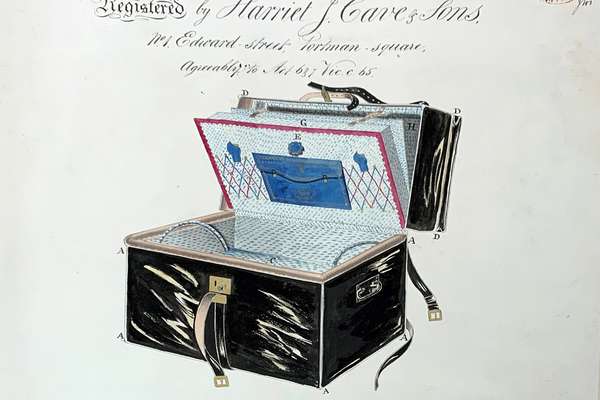In pictures
Top hat designs
The top hat, a tall style of hat with a small brim and a flat top, was a symbol of respectability for the 19th-century middle classes. It became the most popular style of headwear for men. Our registered design records show how inventors devised solutions to the fashion’s impact on everyday life.
Registered design for an elastic dress and opera hat

- Date
- 15 January 1844
- Catalogue reference
- BT 45/1/107
Collapsible top hats, or opera hats, enjoyed a surge of popularity in the 1840s. The design was inspired by opera or theatregoers needing to store their hats away under seats during performances.
The most common design featured a spring mechanism. This allowed the wearer to flatten the hat for easier storage and then to pop it back up into shape with ease. The first collapsible hat using this idea was patented in 1812 by London hatter Thomas Francis Dollman.
James Bickerton Jr, the inventor of this ‘elastic dress and opera hat’, claimed his design could flatten without the aid of a spring.
Registered design for ‘Clark’s Hat Suspender’

- Date
- 4 August 1847
- Catalogue reference
- BT 45/6/1157
James Clark’s hat suspender was designed to be installed on the base of a seat in ‘churches and chapels or elsewhere’. It allowed a hat to be hung by the brim by sliding it on to two parallel bars, for easy storage.
According to the description of the design, its aim was ‘removing all annoyance and injury from the hat being damaged’, providing an insight into some of the grievances of top hat wearers.
Registered design for ‘The Bona Fide Ventilating Hat’

- Date
- 26 March 1849
- Catalogue reference
- BT 45/10/1823
Dress codes made removing a hat in public a social faux pas for the Victorian gentleman. As such, top hats had to be worn in all weathers and indoors. This could cause discomfort when temperatures rose.
Heat would get trapped inside the hat, and there were some reports of the combination of heat, hair oil and sweat building up to cause embarrassing and unpleasant situations for wearers.
There were many designs for solutions to this problem. Some took the form of ventilators for hats. This design by Southwark hat manufacturers John Fuller and Company shows a perforated plate installed in the front of the hat. It had holes in the crown for ‘effectually carrying off the perspiration from the interior of the hat’.
Registered design for a hat cigar holder

- Date
- 20 June 1851
- Catalogue reference
- BT 45/15/2853
Some inventors saw an opportunity in the top hat’s size and shape for the storage of small personal items.
This accessory allowed for several cigars to be stored inside a top hat in a holder that attached to the hat’s lining. The description states that the design’s convenience lay in the wearers not having to carry their cigars in their pocket.
The design was registered in 1851 by brothers Godfrey and Nathaniel Levi. Nathaniel Levi (1830–1908) emigrated from Liverpool to Australia in 1850, where he became the first Jewish member of an Australian state parliament.
Featured article
Record revealed
Registered design for an expanding travelling basket

In 1866, a British luggage manufacturer attempted to capitalise on the expansion of railway lines with a unique and royal travel bag.